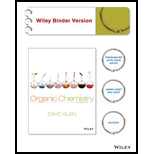
(a)
Interpretation:
The different alkene, alkane products formed for each given substrates when treated with a different reducing reagents are needed to be find out.
Concept Introduction:
Hydrogenation reaction: The hydrogenation is a reduction reaction which results in an addition of hydrogen. Several organic compounds is hydrogenated, it becomes more saturated.
Metal reduction reaction: The
Linder’s catalyst: The
Metal and ammonia reaction: The alkyne involves sodium
(b)
Interpretation:
The different alkene, alkane products formed for each given substrates when treated with a different reducing reagents are needed to be find out.
Concept Introduction:
Hydrogenation reaction: The hydrogenation is a reduction reaction which results in an addition of hydrogen. Several organic compounds is hydrogenated, it becomes more saturated.
Metal reduction reaction: The alkenes can be reduced to alkanes with H2 in the presence of metal catalyst (Pt). The two new C-H σ bonds are formed simultaneously from H atoms absorbed into the metal surface. This type of reaction stereospecific giving only the cis (syn) addition product.
Linder’s catalyst: The alkyne reduced to alkenes to give the cis (Z) alkene.
Metal and ammonia reaction: The alkyne involves sodium
(c)
Interpretation:
The different alkene, alkane products formed for each given substrates when treated with a different reducing reagents are needed to be find out.
Concept Introduction:
Hydrogenation reaction: The hydrogenation is a reduction reaction which results in an addition of hydrogen. Several organic compounds is hydrogenated, it becomes more saturated.
Metal reduction reaction: The alkenes can be reduced to alkanes with H2 in the presence of metal catalyst (Pt). The two new C-H σ bonds are formed simultaneously from H atoms absorbed into the metal surface. This type of reaction stereospecific giving only the cis (syn) addition product.
Linder’s catalyst: The alkyne reduced to alkenes to give the cis (Z) alkene.
Metal and ammonia reaction: The alkyne involves sodium
Want to see the full answer?
Check out a sample textbook solution
Chapter 10 Solutions
Organic Chemistry, Binder Ready Version
- Tarrow_forwardPredict the major organic product(s) of the following reactions. Indicate which of the following mechanisms is in operation: SN1, SN2, E1, or E2.arrow_forward(c) (4pts) Mechanism: heat (E1) CH3OH + 1.5pts each _E1 _ (1pt) Br CH3OH (d) (4pts) Mechanism: SN1 (1pt) (e) (3pts) 1111 I H 10 Ill!! H LDA THF (solvent) Mechanism: E2 (1pt) NC (f) Bri!!!!! CH3 NaCN (3pts) acetone Mechanism: SN2 (1pt) (SN1) -OCH3 OCH3 1.5pts each 2pts for either product 1pt if incorrect stereochemistry H Br (g) “,、 (3pts) H CH3OH +21 Mechanism: SN2 (1pt) H CH3 2pts 1pt if incorrect stereochemistry H 2pts 1pt if incorrect stereochemistryarrow_forward
- A mixture of butyl acrylate and 4'-chloropropiophenone has been taken for proton NMR analysis. Based on this proton NMR, determine the relative percentage of each compound in the mixturearrow_forwardQ5: Label each chiral carbon in the following molecules as R or S. Make sure the stereocenter to which each of your R/S assignments belong is perfectly clear to the grader. (8pts) R OCH 3 CI H S 2pts for each R/S HO R H !!! I OH CI HN CI R Harrow_forwardCalculate the proton and carbon chemical shifts for this structurearrow_forward
- A. B. b. Now consider the two bicyclic molecules A. and B. Note that A. is a dianion and B. is a neutral molecule. One of these molecules is a highly reactive compound first characterized in frozen noble gas matrices, that self-reacts rapidly at temperatures above liquid nitrogen temperature. The other compound was isolated at room temperature in the early 1960s, and is a stable ligand used in organometallic chemistry. Which molecule is the more stable molecule, and why?arrow_forwardWhere are the chiral centers in this molecule? Also is this compound meso yes or no?arrow_forwardPLEASE HELP! URGENT!arrow_forward
 ChemistryChemistryISBN:9781305957404Author:Steven S. Zumdahl, Susan A. Zumdahl, Donald J. DeCostePublisher:Cengage Learning
ChemistryChemistryISBN:9781305957404Author:Steven S. Zumdahl, Susan A. Zumdahl, Donald J. DeCostePublisher:Cengage Learning ChemistryChemistryISBN:9781259911156Author:Raymond Chang Dr., Jason Overby ProfessorPublisher:McGraw-Hill Education
ChemistryChemistryISBN:9781259911156Author:Raymond Chang Dr., Jason Overby ProfessorPublisher:McGraw-Hill Education Principles of Instrumental AnalysisChemistryISBN:9781305577213Author:Douglas A. Skoog, F. James Holler, Stanley R. CrouchPublisher:Cengage Learning
Principles of Instrumental AnalysisChemistryISBN:9781305577213Author:Douglas A. Skoog, F. James Holler, Stanley R. CrouchPublisher:Cengage Learning Organic ChemistryChemistryISBN:9780078021558Author:Janice Gorzynski Smith Dr.Publisher:McGraw-Hill Education
Organic ChemistryChemistryISBN:9780078021558Author:Janice Gorzynski Smith Dr.Publisher:McGraw-Hill Education Chemistry: Principles and ReactionsChemistryISBN:9781305079373Author:William L. Masterton, Cecile N. HurleyPublisher:Cengage Learning
Chemistry: Principles and ReactionsChemistryISBN:9781305079373Author:William L. Masterton, Cecile N. HurleyPublisher:Cengage Learning Elementary Principles of Chemical Processes, Bind...ChemistryISBN:9781118431221Author:Richard M. Felder, Ronald W. Rousseau, Lisa G. BullardPublisher:WILEY
Elementary Principles of Chemical Processes, Bind...ChemistryISBN:9781118431221Author:Richard M. Felder, Ronald W. Rousseau, Lisa G. BullardPublisher:WILEY





